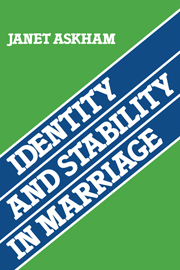Book contents
- Frontmatter
- Contents
- Preface
- 1 Prologue
- 2 Ways of looking at marriage: an introduction to the study
- 3 Knowing and talking to each other
- 4 Separate and joint activity
- 5 Constraints on behaviour within marriage
- 6 Changes in self and in activities
- 7 Relationships outside marriage
- 8 Conclusion
- Appendix 1 Sample selection
- Appendix 2 Interview guide
- Appendix 3 Profiles of the couples
- Glossary
- Bibliography
- Index
4 - Separate and joint activity
Published online by Cambridge University Press: 07 October 2011
- Frontmatter
- Contents
- Preface
- 1 Prologue
- 2 Ways of looking at marriage: an introduction to the study
- 3 Knowing and talking to each other
- 4 Separate and joint activity
- 5 Constraints on behaviour within marriage
- 6 Changes in self and in activities
- 7 Relationships outside marriage
- 8 Conclusion
- Appendix 1 Sample selection
- Appendix 2 Interview guide
- Appendix 3 Profiles of the couples
- Glossary
- Bibliography
- Index
Summary
The answers reported in the previous chapter suggest that most couples perceive themselves as talking to each other a good deal but also as avoiding some topics on some occasions. Such a situation appeared satisfactory to them; but on the other hand dissatisfaction was not always expressed when there appeared either relatively little talk or an absence of topic avoidance (that is, some of the people whose answers placed them at the extremes said they were unhappy about the situation but some did not). This chapter examines whether a similar ‘middle way’ was reported in another area of marital behaviour, and whether dissatisfaction always accompanied interviewees' reports which placed them at the extremes. The subject of the chapter is the perceived extent to which husband and wife engage in separate activities, or spend time apart or together; the causes of separation, and also people's stated attitudes towards their situation, will be examined. Again it was anticipated that most people would report compromise situations and would say they found them acceptable; and that those particularly high or low on separation would voice discontent. It will be shown that the former appeared to be the case and that the latter hypothesis to some extent also held true.
Amount and type of separate and joint activity
The working lives of married couples tend to separate them from each other for longer periods than any other activity, except in those rare cases where one partner works at home and the other does not work, or where both work in the same establishment.
- Type
- Chapter
- Information
- Identity and Stability in Marriage , pp. 55 - 83Publisher: Cambridge University PressPrint publication year: 1984



